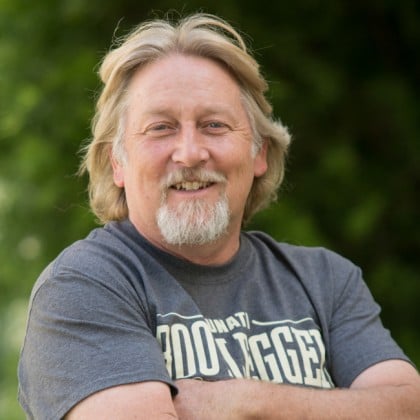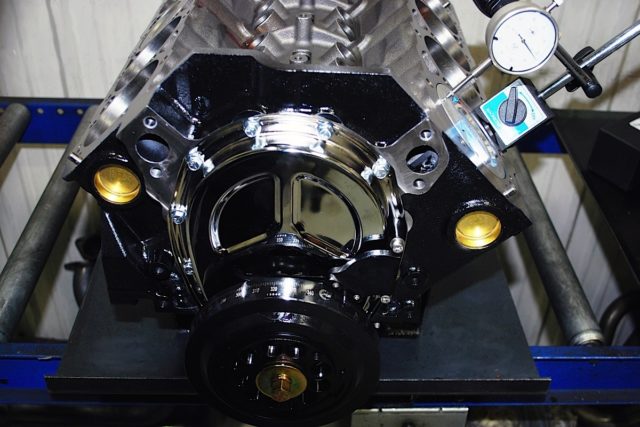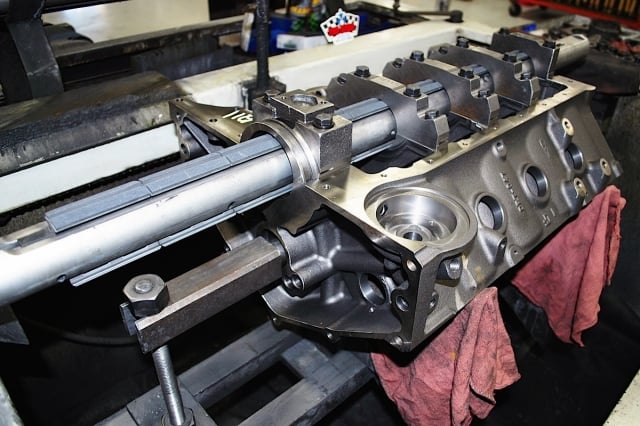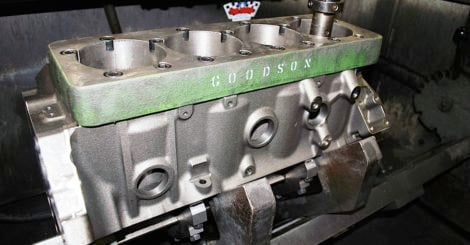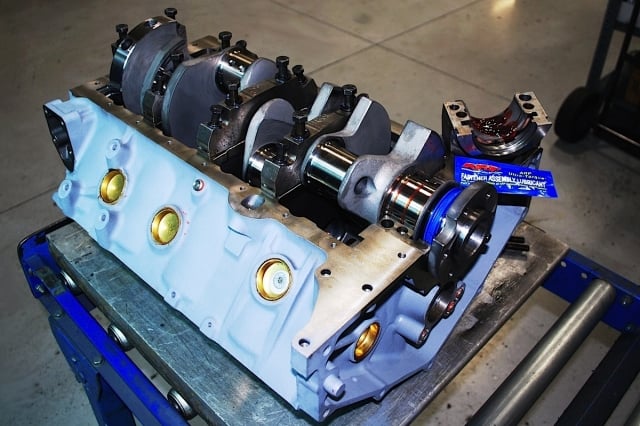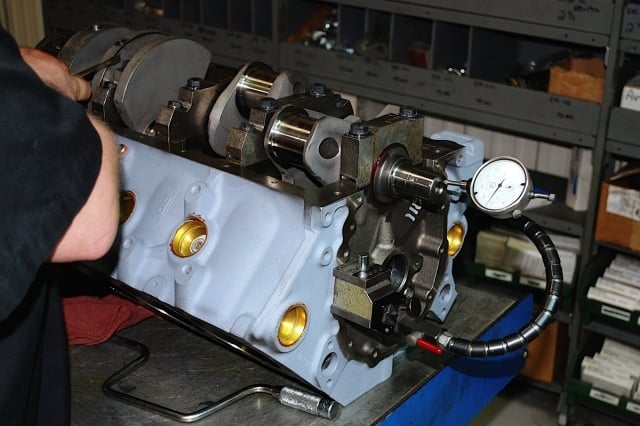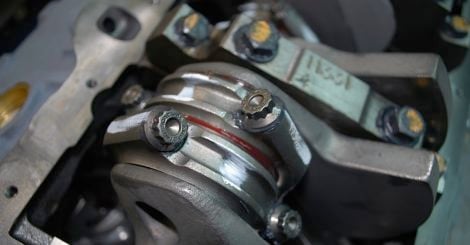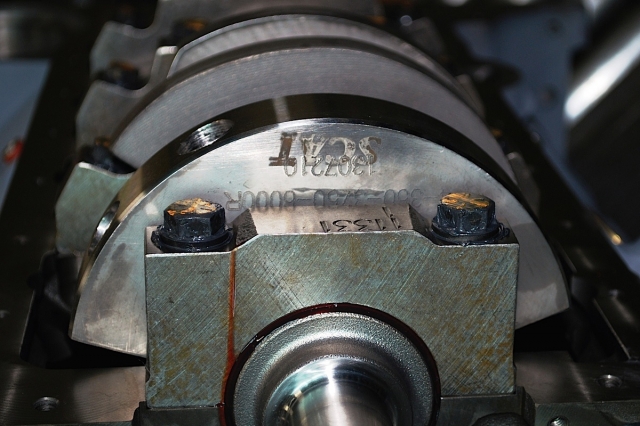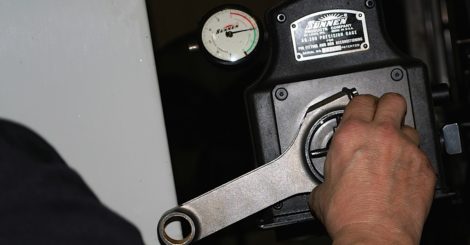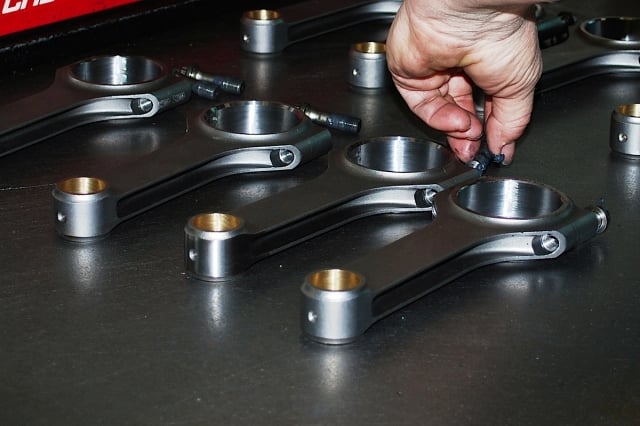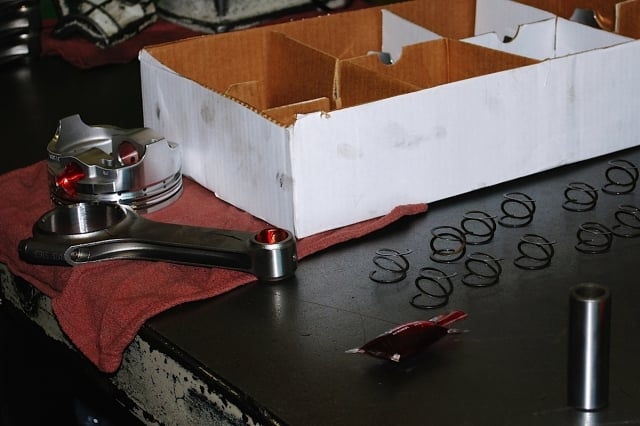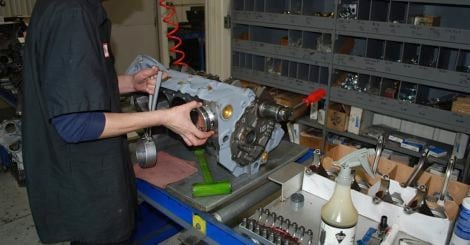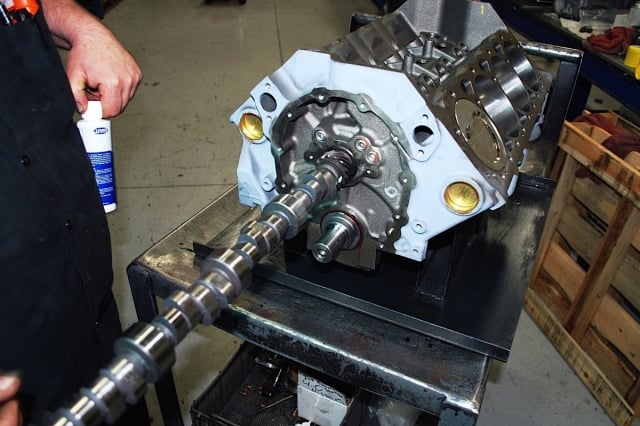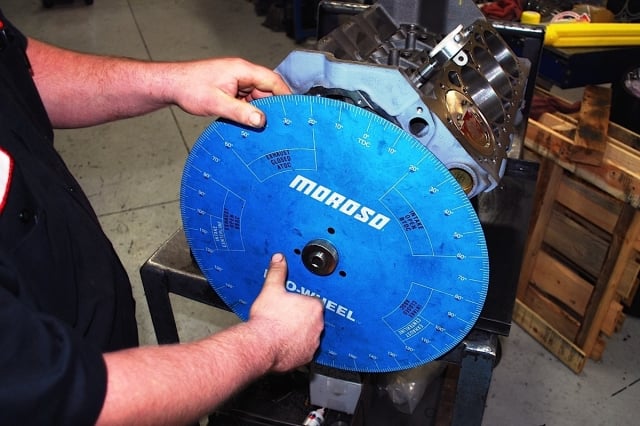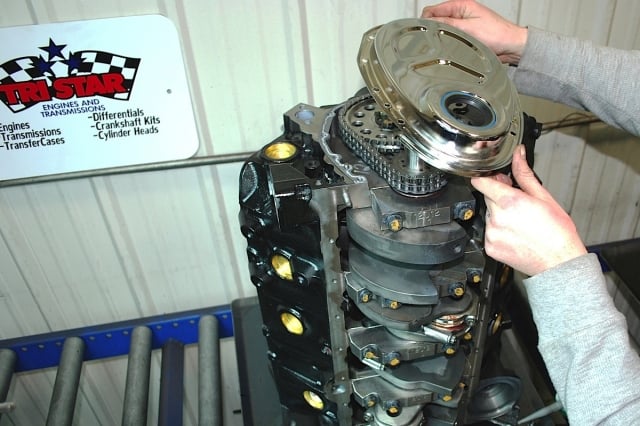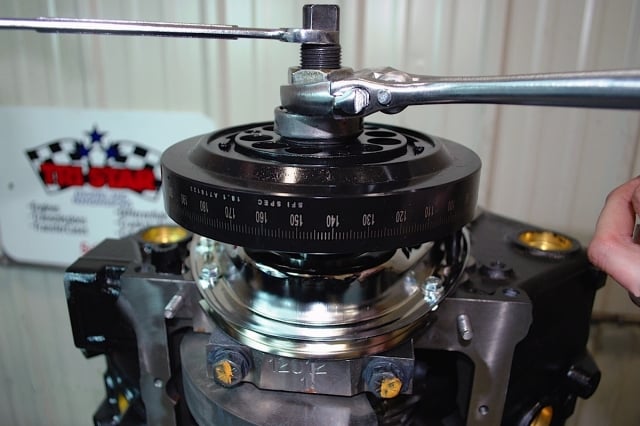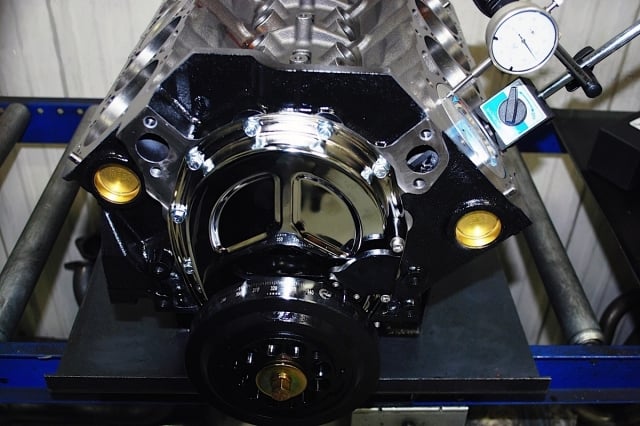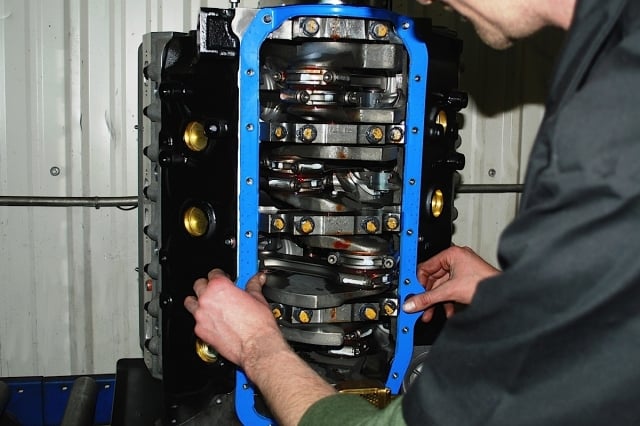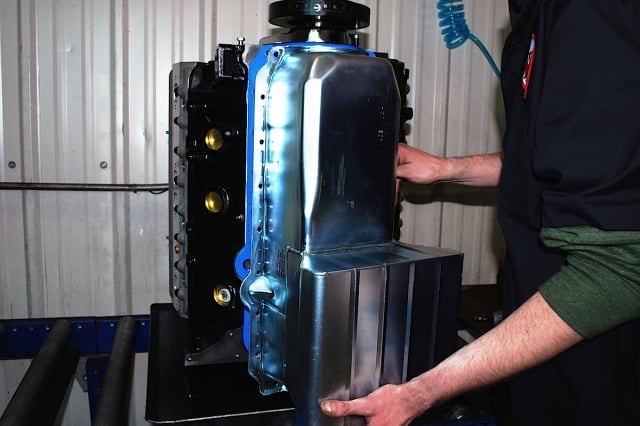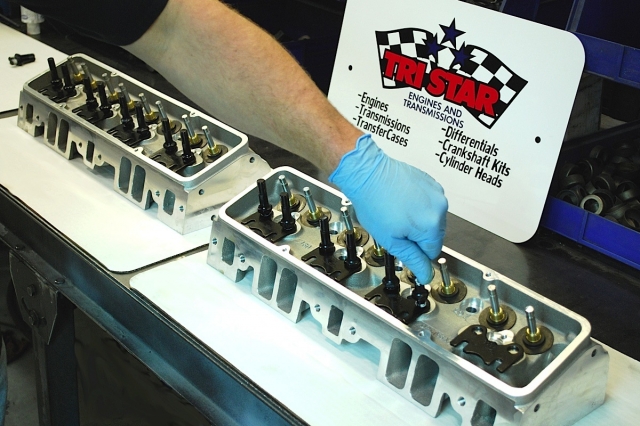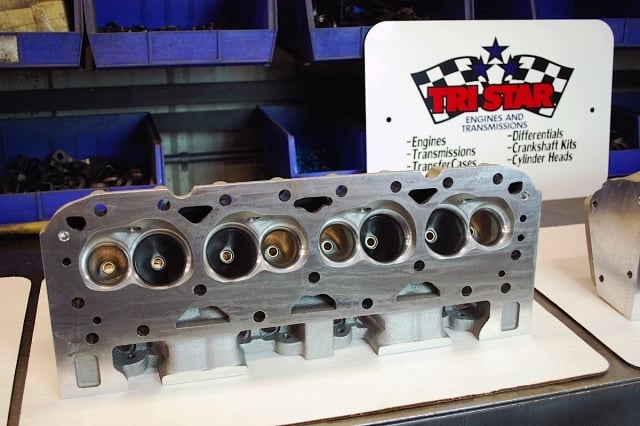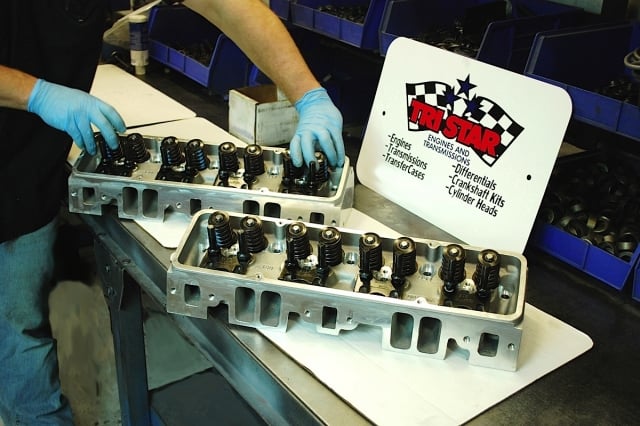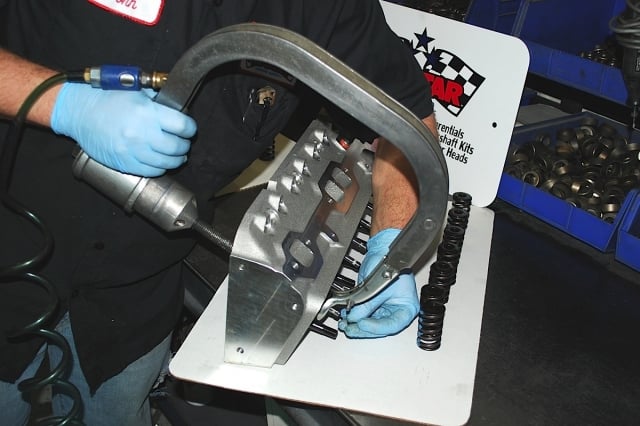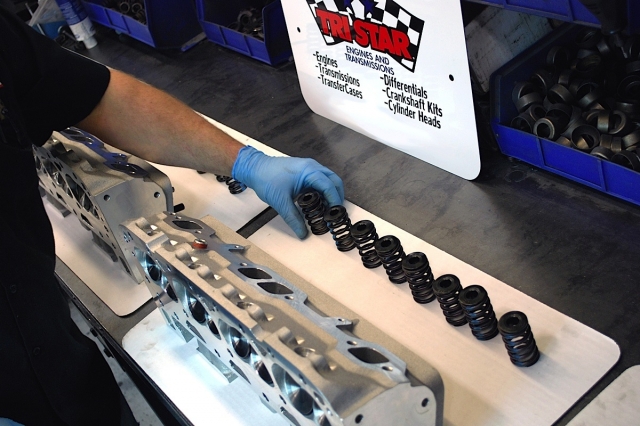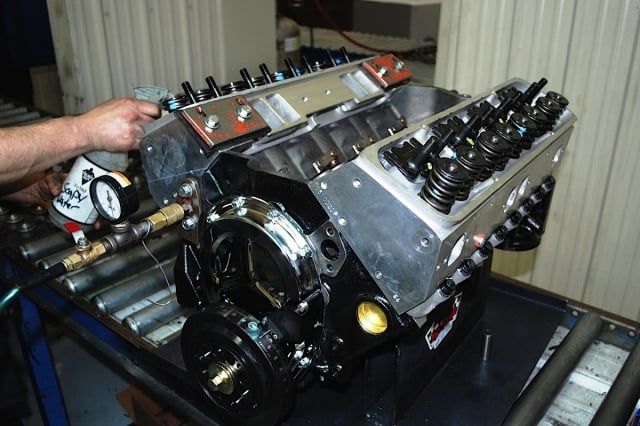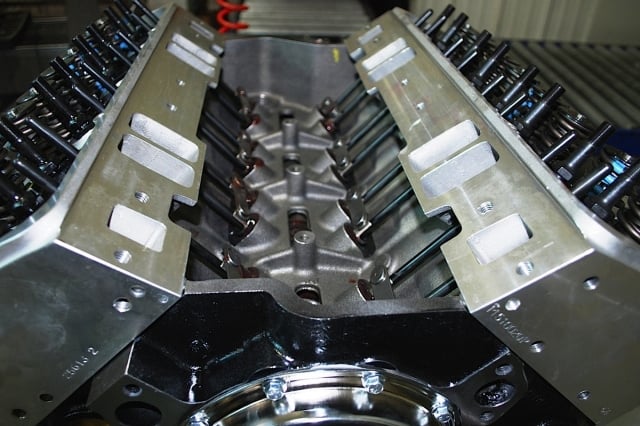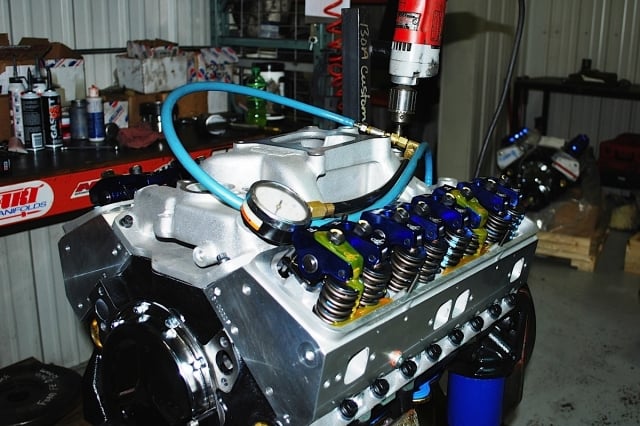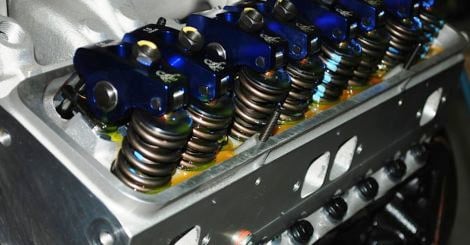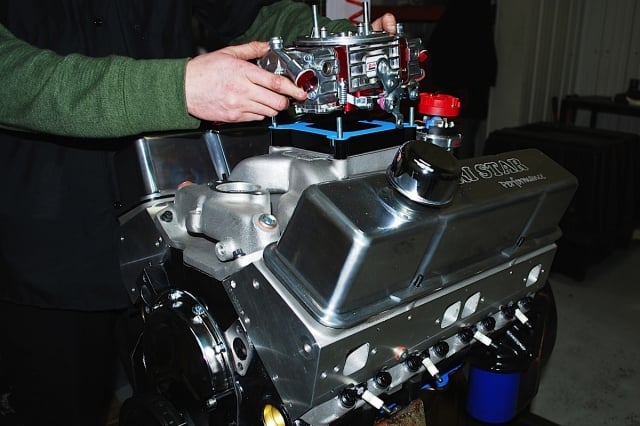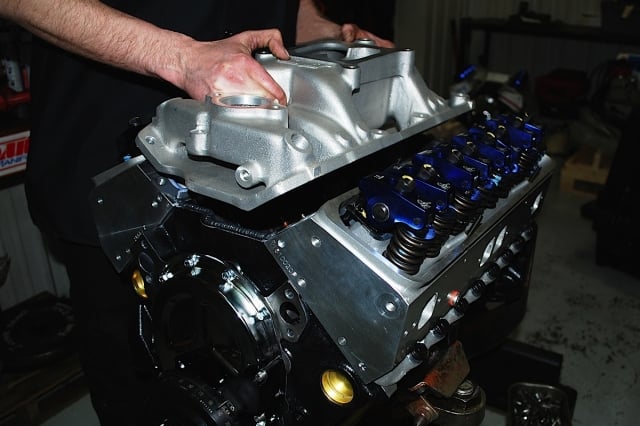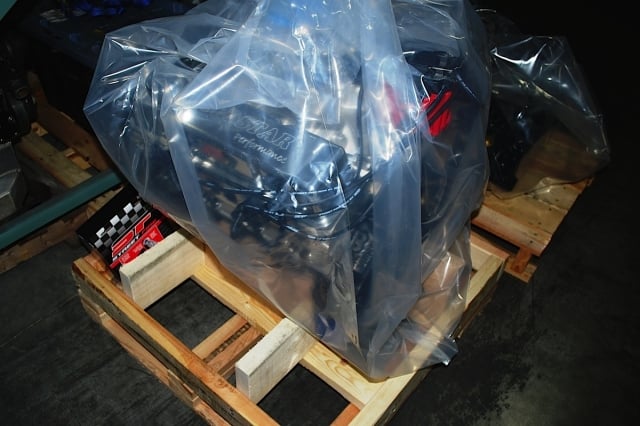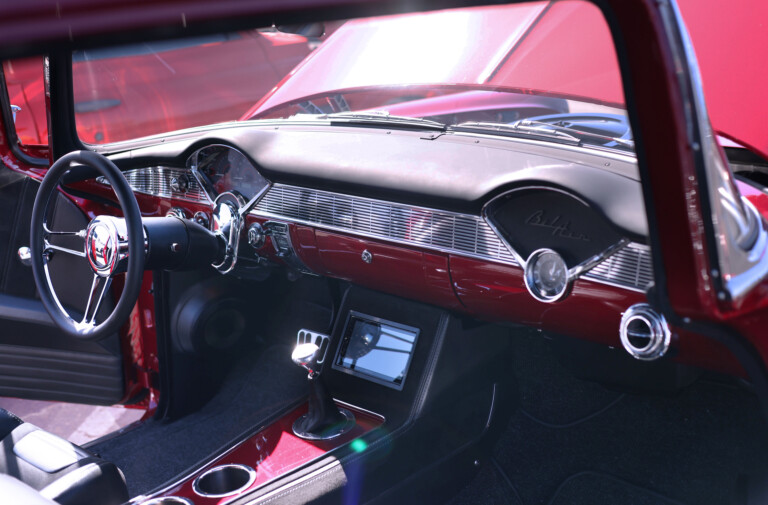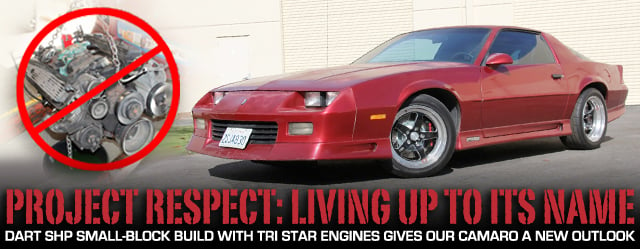 Project Respect is our own third-gen Camaro and while it may have started out as a mullet-machine it’s been slowly getting the respect that this once popular F-body deserves. With roots going back to 1967, we plan to give this Camaro the attention it is worthy of – and then some.
Project Respect is our own third-gen Camaro and while it may have started out as a mullet-machine it’s been slowly getting the respect that this once popular F-body deserves. With roots going back to 1967, we plan to give this Camaro the attention it is worthy of – and then some.
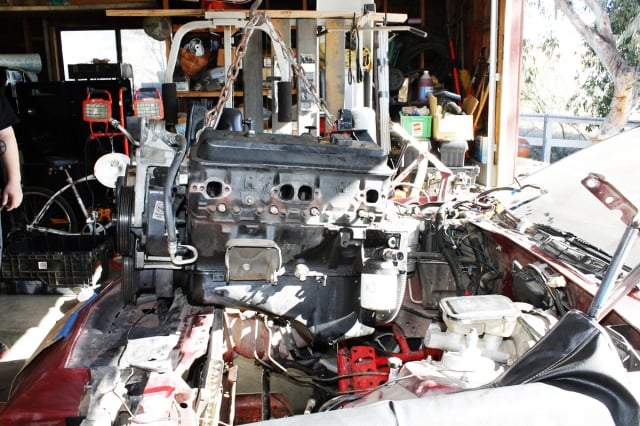
Out with the old. The SBC was fine for it’s day when power was reduced in favor of emissions and economy, but it certainly didn’t give this Camaro any respect.
Project Respect, our 1991 Camaro RS, was due for an engine that would allow Respect to live up to its reputation. We installed a set of Hooker headers on the tired SBC and performed a major Spohn front suspension upgrade. We upgraded the rearend with a Moser 12-bolt with Spohn torque arms and QA1 shocks with Eibach springs, and then installed Weld Racing wheels and Toyo tires, all to give our Camaro the proper stance.
To get Respect halted with all these handling upgrades, Baer brakes did the trick for us. But that TCI Auto 700R4 was lacking motivation being mated up to the tired mill, and that’s when we turned to Tri Star Engines and Transmissions for a powerplant that is worthy of Respect.
This latest upgrade for Project Respect puts it on ‘roids: a very potent SBC engine build aimed at 500+ horsepower. We looked to our friends at Tri Star Engines to complete this build for us, and they built their Pro Star 406 cubic inch SBC with a Dart SHP block and SHP heads to put our Camaro back on the map where it belongs.
Tri Star is well known for their high performance crate engines, as well as OE replacement and marine engines. Their own CNC machining center will assure us that this build will be done to their own specifications. They blueprint all of their parts and dyno test all complete assemblies, this assures their customers that they’re getting the most performance and lasting quality with each build.
Tri Star was founded in 1988, and now has over 90,000 square feet of space for manufacturing and warehousing. We’ve enjoyed watching some of their builds on their YouTube channel, showing us the kind of power that they are building into their performance builds for customers. The full service shop does all machining, assembly, and dynamometer testing in house, so they control all aspects of the engine build.
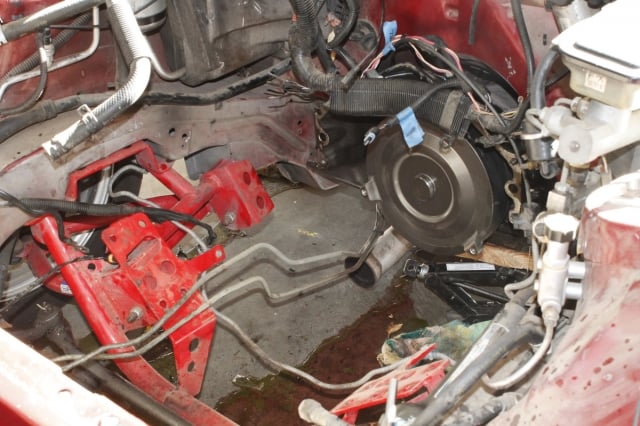
With the old SBC removed, the engine bay became the new home for the Tri Star 406 cubic inch Pro Star small-block, built with Dart’s SHP block, heads, and intake.
Project Respect Goes SHP
Short Block Build
- Dart SHP block – part #31161211
- Cast iron
- 4-Bolt mains
- 4.125-inch Siamese bore
- 2-Piece rear main seal
- SCAT crankshaft – part #435056
- Forged 4340 steel
- 3.750-inch stroke
- SCAT rods – part #6600021S
- H-Beam
- 7/16-inch cap screws
- Icon pistons – part #IC758
- .030
- Step dish
- 15.2cc head volume
- Clevite main bearings – part #MS909H
- Clevite rod bearings – part #CB663HN
- Howards camshaft – part #110275-10
- Hydraulic roller tappet
- Duration: 298/306
- Lift: .545/.562
- ARP engine bolt kit – part # 534-9501
- Moroso oil pump – part #22101
- Moroso oil pan – part #20201
- Fel Pro oil pan gasket – part #P34510
To start off this build for ‘Respect’, Tri Star begins with the SHP (Special High Performance) small-block Chevy cast iron block (part #31161211) from Dart Machinery. This is a new block that is precision machined by Dart, built on 350 mains with a 4.125-inch cylinder bore, and a 9.025-inch deck height.
The extra thick deck ensures a dependable head gasket seal. The cylinders on this block were bored out .030 over from its standard 4.125 bore, bringing the cylinders to 4.155 with a 3.750 stroke.
The block will fit in place physically where any stock SBC resides, and all accessory drives, water pump, bell housing, and cylinder head deck surfaces are similar to the OE GM block. That’s where OE ends and the performance begins.
The purpose of the Dart SHP block and heads was to compete directly with GM in the crate engine arena. Dart was able to provide builders with an affordable, high-quality CNC’d block and heads that required little to no machining. The SHP line puts higher performance in the hands of the builders at relatively the same cost that GM could offer.
The block itself is a siamese bore, which means there are no coolant passages between the cylinder walls. This allows for a thicker wall for boring out the cylinders and less of a chance for cylinders to be affected by extreme temperatures or pressures. This feature was one that was carried over from Dart’s racing blocks. Another feature that Dart brought from their high-end blocks is the priority oiling system, for optimum lubrication of important components.
The priority oiling system has the main oil gallery beside the cam tunnel, instead of above it as it is in a stock SBC. With the OE oiling system, oil is directed to the camshaft first and the main bearings second. With Dart’s priority oiling, oil is directed at the main bearings first, which helps lubricate the crankshaft at higher RPMs. The camshaft and valvetrain, which don’t have the same demands for oiling as the crankshaft, have oil delivered through secondary passages.
These castings are able to withstand prolonged drivability or sportsman style drag racing on a budget. -Mike Sanders
Four-bolt mains were also essential to make the SHP a true high-performance alternative to their racing blocks. The SHP is a high performance block with the same dimensions as the SBC. This allows for stock and aftermarket parts to fit without modification. However, the SHP is anything but a standard replacement block – consider it a cost-effective alternative to a racing block that still allows for a higher power potential than a standard block.
“The SHP blocks were designed for street/strip and heavy-duty applications. These castings are able to withstand prolonged drivability or sportsman style drag racing on a budget,” Sanders said. “The main focus of the SHP block was to bridge the gap between the stock GM castings and full race blocks like the Little M and Iron Eagle, but at an affordable cost.”
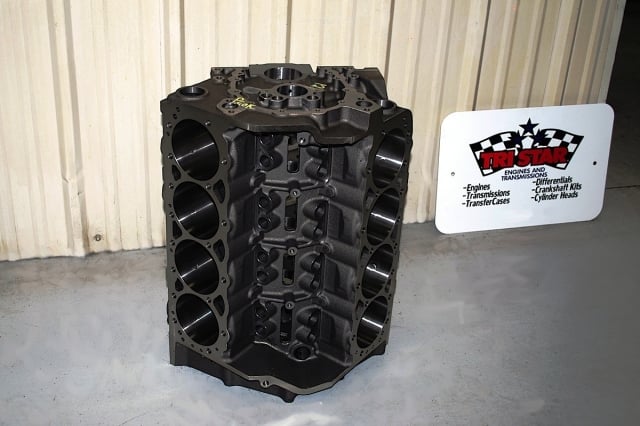
The Dart SHP block comes bare. Tri Star machines the block and uses it as the base for the Pro Star 406 for our Camaro.
Short Block Assembly
The first order of business with the SHP block was to deck the block for correct height for the rod/piston/stroke combination, and to bore the cylinders out for correct piston to cylinder wall clearances. Tri Star checks every block and does all machine work themselves.
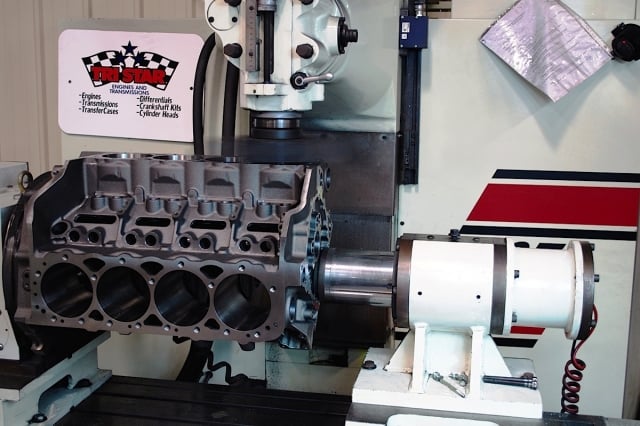
The first step is to machine the bare block, this gives a flat, smooth surface for the cylinder heads.
The Siamese bores have extra thick cylinder walls, and the overbore of .030 inches brought the cylinders to 4.155. All parts were ordered ahead of time and the rotating assembly consisted of Scat crank and rods, with Icon pistons and pins. The rotating assembly is installed using Clevite main and rod bearings and is held together with ARP hardware throughout.
Before any components are bolted to the block, however, Tri Star align hones the crank journals. This consists of bolting the caps into place and honing the bearing journals, assuring that the fit and finish is perfectly round and honed to the proper size of the bearings. If the hole size is not correct, or it’s not perfectly round, the oil clearance won’t be correct. This can result in premature crankshaft wear, or worse – complete engine failure.
Left: Align honing the crankshaft journals ensures that the holes are round and aligned perfectly. Right: Torque plate honing the cylinders allows honing them as they would be with the cylinder heads torqued down.
Another operation that is done is to torque plate hone the cylinders. This is done by bolting a thick steel or cast plate to the block deck so that the cylinders can be honed to simulate the stress and pressures that would exist when the cylinder head is installed. It might not seem like it, but the the cylinder walls can distort slightly when the cylinder head bolts are torqued.
The SHP block was designed by Dart to be an alternative to building a non-race factory short block without going to the higher pricing of a race block. If you look at the benefits of the SHP over stock, you’ll find some features are closer to a race block than to the stock SBC. While the SHP is not designed for a dry sump system like the race block, it does deliver oil pressure differently than the SBC.
Before the rest of the short-block is assembled, the crankshaft is checked for end play. When Tri Star is satisfied with it, the bottom end is tightened up and the build commences.
With many high performance builds on factory blocks, you risk potential damage because stock blocks weren’t designed for higher horsepower applications. A race block, of course, has all features built in that a high horsepower race engine demands, some of which aren’t practical on a street driven car. The SHP is the happy medium, giving you the performance potential of the race block, at a much lower cost, and the reliability of the stock block, with the capability of handling more power.
The four-bolt mains on the SHP have splayed outer bolts on the three middle caps for strength; this helps to eliminate what is called cap walk. Cap walk happens when the forces of the crankshaft allow the caps to move from side to side under higher pressures. Splaying the outer bolts, meaning they are drilled at a slight angle, eliminates cap walk because the angle of the bolts won’t allow the caps to move from side to side.
Four bolt-mains provide more surface contact with the block and this also helps eliminate cap walk issues. For this build, it’s important to go with the four-bolt mains due to the additional stress that can be expected from a stroked engine. These features are important when building a performance block and getting the biggest bang for your buck is what the SHP is all about.
Every aspect of this build is checked out, no parts were bolted on straight out of the box without prior inspection. You don't build a 500+ horsepower engine without doing your homework.
Tri Star assembles the block on the bench using assembly lube where needed and measuring for tight tolerances. With the crankshaft installed, the next step is to measure for crankshaft end play.
After the crankshaft is checked and properly installed, the Scat H beam rods are verified for size and the Icon pistons are installed. Once the rod and piston are assembled together the complete assembly is checked for straightness. Finally, the Howard’s file fit rings are fitted to the bores and the complete rod and piston assembly is installed in the corresponding bore using Clevite H series bearings.
With the pistons, rings, and pins installed to the connecting rods, the pistons can be inserted into the bores and rod caps torqued in place. It’s very important to make sure that the proper rod caps are kept with the connecting rod they were shipped with, mixing rod caps can also bring about engine failure.
Degreeing the camshaft is also an important step in the build. Aligning the cam and crank assures that timing can be set properly prior to the dyno pull.
The camshaft is installed using cam lube and care is taken to insert the cam without causing damage to the cam bearings. Before the timing chain is installed, Tri Star degrees the camshaft to make sure that it is properly timed with the crankshaft. A degree wheel helps them achieve the proper timing before the chain is put in place and the timing cover installed.
With the camshaft degreed and the timing cover installed, the oil pump and the oil pan can be installed before assembling the top end.
What You Don’t See – ARP Hardware
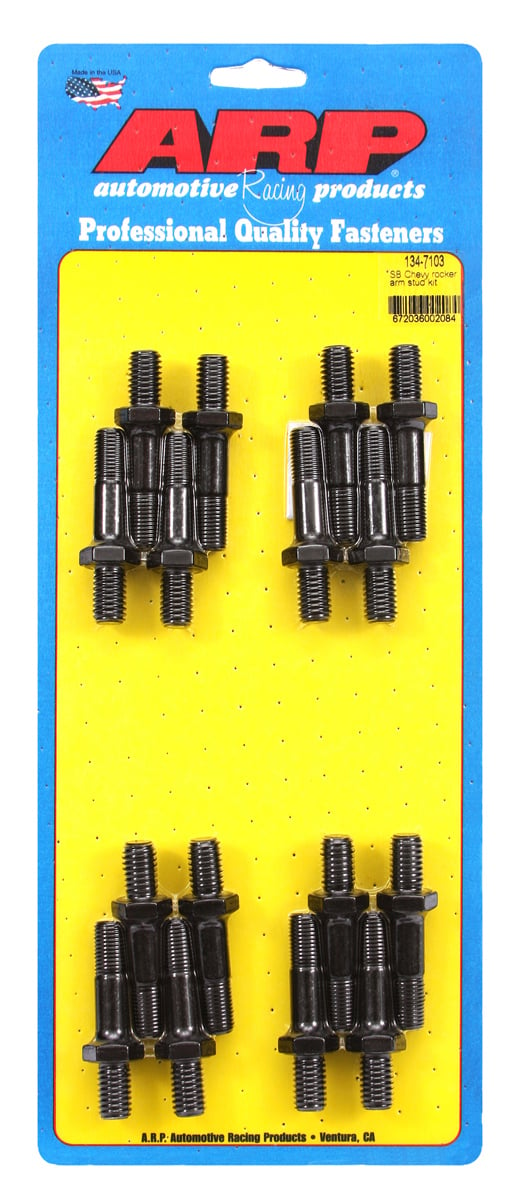 Tri Star used ARP fasteners for Project Respect because they know that they can count on ARP to keep their builds together. When you build a high-performance engine, using quality hardware to bolt it all together is paramount. Assembling an engine with used or low quality hardware can turn an engine into a big paperweight if the bolts can’t keep it together. Companies like ARP put their reputation on the line day in and day out with their engine hardware, which has been used in racecars and high-performance builds for decades.
Tri Star used ARP fasteners for Project Respect because they know that they can count on ARP to keep their builds together. When you build a high-performance engine, using quality hardware to bolt it all together is paramount. Assembling an engine with used or low quality hardware can turn an engine into a big paperweight if the bolts can’t keep it together. Companies like ARP put their reputation on the line day in and day out with their engine hardware, which has been used in racecars and high-performance builds for decades.
Automotive Racing Products (ARP) was founded by Gary Holzapfel after he saw many of his friends end up with broken engines because of fastener failure. Taking on his many years of experience with making fasteners for the aerospace industry, he decided it was time for the racing world to have the proper fasteners to hold their engines together. These days, you can find ARP fasteners in just about any drivetrain or engine application, including OEM, Formula 1, IndyCar, NASCAR and NHRA, as well as marine applications.
Grade 5 or grade 8 hardware store fasteners are fine for bolting components onto a vehicle, but when it comes to the engine, rely on a bolt that was made for the engine – and not one that was made for a bumper or fender. Most factory head bolts, for example, are considered “torque to yield” which means they are designed to stretch and they are a one-time use only. Once they have stretched, they can no longer be torqued properly and the tensile strength is compromised.
ARP fasteners are 100% built in-house using precise tolerances and stronger alloys, and many of them can be reused once they have been torqued properly. Depending on the material used in a bolt and its ductility, the amount that it stretches when torqued can vary. Higher quality bolts, such as ARP, are built using the stretch factor. According to ARP, bolts must be stretched a certain amount, and the material’s ability to rebound and return to the original length is how it provides clamping force.
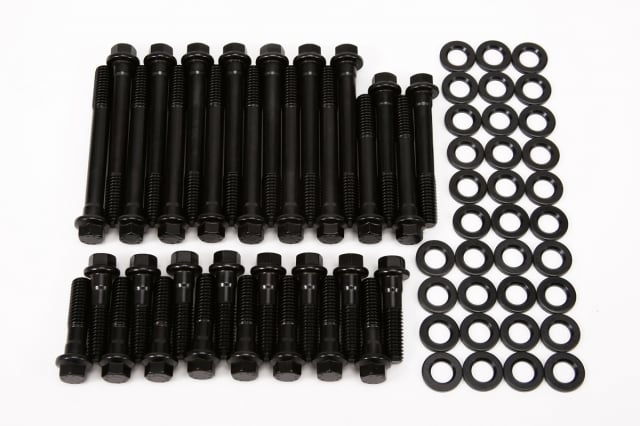
ARP hardware is used throughout the build. You don’t typically see it once the engine is completed, but knowing it’s there assures that it will stay together at higher rpms.
However, every bolt has a yield strength, or yield point, where the bolt has been stretched too much from being overtightened. This makes the bolt no longer usable, as the preload (or clamping force) can no longer be achieved.
ARP says that as a rule of thumb, any fastener that measures .0005 inches longer than its original length has been compromised and should be replaced. For this reason, ARP bolts should be torqued to the proper specifications each and every time. Going too far – or not enough – will not provide the amount of clamping force that is required.
Another factor to consider is assembly lube on engine fasteners. Some lubricants, like motor oil, inhibits the fasteners ability to achieve the required preload, and it may require several cycles before final torquing. The amount of friction on a bolt can affect the the torque required. This effect is called preload scatter, and is the difference between the amount of preload on the first installation and the amount of preload on subsequent cyles. ARP recommends using Ultra-Torque Fastener Assembly Lubricants to keep preload scatter to a minimum.
Dart SHP Cylinder Heads
The cylinder heads are sent bare and Tri Star checks the heads and assembles them there at the shop using quality components, such as Ferrea valves, Elgin springs, Howard’s lifters and Scorpion roller rockers. After inspection, the guides are machined and the valve seats are three-angle machined for performance. The heads are 100% pressure tested and gasket surfaces are machined to the manufacturer’s specs so that final combustion chamber volume can be achieved. After assembly, the heads are vacuum tested to insure proper valve sealing before installation on the engine.
Cylinder Heads
- Dart SHP heads – part #127311
- Bare aluminum
- 64cc combustion volume
- 200cc intake port volume
- Ferrea valves
- 2.02 intake – part #2469C
- 1.60 exhaust – part #2470C
- Elgin valve springs – part #RV-9902ZK
- 1.437 diameter
- Style: dual
- Max lift: .600
- ARP head bolts – part #134-3601
- 7/16-20 SBC kit
- Scorpion Roller Rockers – part #90072
- Howards street series lifters – part #91164N
- Hydraulic roller
- Vertical bar
- Chromoly pushrods & retainers
- Fel Pro head gaskets – part #P1003-BK
- Tri Star valve covers
Sanders explained that the SHP heads were designed for street/strip and heavy-duty applications just like the SHP blocks. Where they differ from their Pro1 SBC heads would be cost and performance. The Pro1 heads were designed from the ground up, netting nearly 30hp over the previous heads. For the SHP heads, Sanders said, “We were able to re-use and modify some older tooling we had from a previous design, which took the cost factor of a new cylinder head build out of the equation. This produced a cheaper price point but utilized slightly older technology that still out-performed the stock GM heads by miles.”
The SHP heads use a standard valve angle and spacing to allow the use of standard valvetrain components, with multi-angle intake seats and radiused exhaust seats to increase air/fuel flow. Since ‘Respect’ is going to be a street driven car, the hardened exhaust seats are compatible with unleaded gasoline.
The heads have been machined for the 1.437 diameter valve springs and retain the straight spark plug configuration. Once Tri Star makes their initial inspection, all guides are machined to final specs and valve seats are given a three-angle machining for maximum performance.
With many builds, to get optimum performance the heads and intake are port-matched to eliminate any disruption in the flow. However, with Dart’s SHP heads and intake, Tri Star says they’re matched very well and port matching isn’t necessary.
The SHP heads are shipped bare. Tri Star machines the surfaces and performs a three-angle grind on the valve seats.
Testing the heads, the flow numbers come in at 252 cfm @.500-inch for the intake side, and 186 cfm @.500-inch on the exhaust side. These figures align with what the goal was for this build: increasing air flow and maximizing what is there. This enables the engine to perform at its best with the right components and to make the kind of power that is expected.
After the heads have been pressure tested and inspected, they're torqued to specs and the valvetrain is installed .
Final Engine Assembly
After assembling the block and torquing the heads to the proper specs, the final assembly includes the rest of the components that will allow the engine to be run on a dyno for horsepower figures. With the Dart SHP block and heads, we also turned to Dart for the matched SBC intake manifold (Part #42811000.
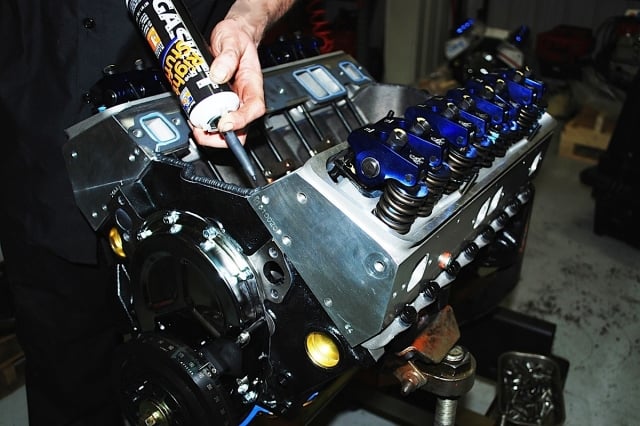
A thick bead of silicone gasket sealer is applied to the front and rear of the block for a secure seal.
The intake manifold is installed with gaskets and silicone sealer at the ends. The RTV sealant is applied liberally to give a complete seal of the intake at the front and rear of the block.
The plenum and runners on this dual-plane manifold are raised, providing a layer of air beneath that insulates the air/fuel mixture from the head that the engine produces. The denser intake charge that this creates will provide more power, while the dual plane design maximizes the mid-range torque. Inside the plenum, the ribbed floor promotes fuel atomization for a better mixture, thus creating a more complete burn of the fuel.
The intake accepts the standard 4150-style carburetor or throttle body, has a raised water cross-over, integral bosses for nitrous injectors, and dual distributor hold-downs for making timing adjustments easier. The remaining components are installed, including the MSD Pro-Billet distributor and wires, water pump, and Moroso oil pan.
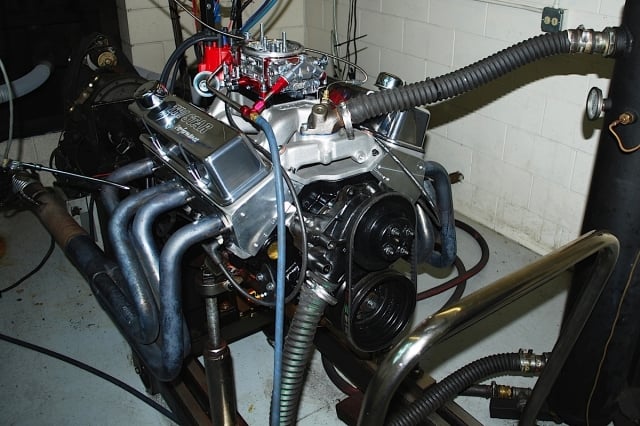
After final assembly, our completed Pro Star 406 is run on the dyno, as are all of Tri Star’s builds.
The MSD distributor (Part #85551) and Super Conducter 8.5mm plug wires (Part #31359) are designed for Chevrolet big/small-block applications and must be used with an MSD ignition control, such as the MSD 6 or MSD 6AL. They utilize a mechanical advance instead of vacuum advance. This mechanical advance allows for replacing springs in the centrifugal advance mechanism to achieve the desired total ignition timing, regardless of what the initial (base) timing is. Lighter springs will allow a quicker advance, heavier springs will slow it down. After installing the distributor, setting the timing may take a few test runs and changing springs to achieve proper total timing, depending on the build. Topping off our build is a Quick Fuel 750 cfm carburetor with an electric choke (Part #SS750), plenty big enough for the build.
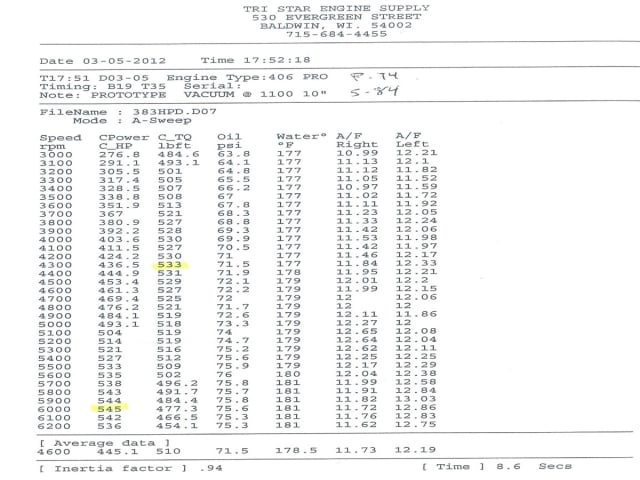
The Tri Star 406 cubic inch Pro Star engine pulled down 545.0 hp and 533.0 lb-ft of torque. That’s a lot of ponies for this Camaro, and the target was achieved with this build.
We do plan on regular driving with Project Respect, so it was important to be sure that 93 octane is sufficient, especially on a high compression engine. In addition to being drivable, it was also built for performance and we wanted to know what kind of power this engine was putting out. After getting it on the dyno, Tri Star was able to pull 545.0 hp at 6,000 rpm, and 533.0 lb-ft of torque at 4,300 rpm. This combination provides plenty of low end torque to get the car moving, lots of top end power to keep it moving, and a great overall combination for Project Respect.
After the dyno run, the engine is wrapped up and packed on a crate and sent to the customer.
Proper Break-In Procedures
With any new engine, it’s important to break it in properly and allow the rings to seat. Some will tell you to drive the car like you normally would, and not to baby it, and that is sometimes good advice – as long as you don’t over do it and follow some guidelines while you’re at it. Tri Star says to avoid extended idling and vary speeds for the first 100-200 miles of driving. Change the oil at 250 miles from first start up, then regularly every 3,000 miles or every 3 months.
Tri Star also explained that because this engine is fitted with a roller camshaft, cam break in is not needed. On a typical non-roller it’s recommended to run the engine at 2,000 rpm for 20 minutes to break in the cam and rockers properly, but roller cams/rockers are adjusted with zero backlash, meaning no gaps between valve stem and the facing on the roller rocker arms.
Now that we have the engine built and ready to go, a good break-in period will commence and the car will be ready to be strapped down on our Dynojet and we’ll get some RWHP numbers. Remember to check back for our chassis dyno story and future articles for Project Respect.


